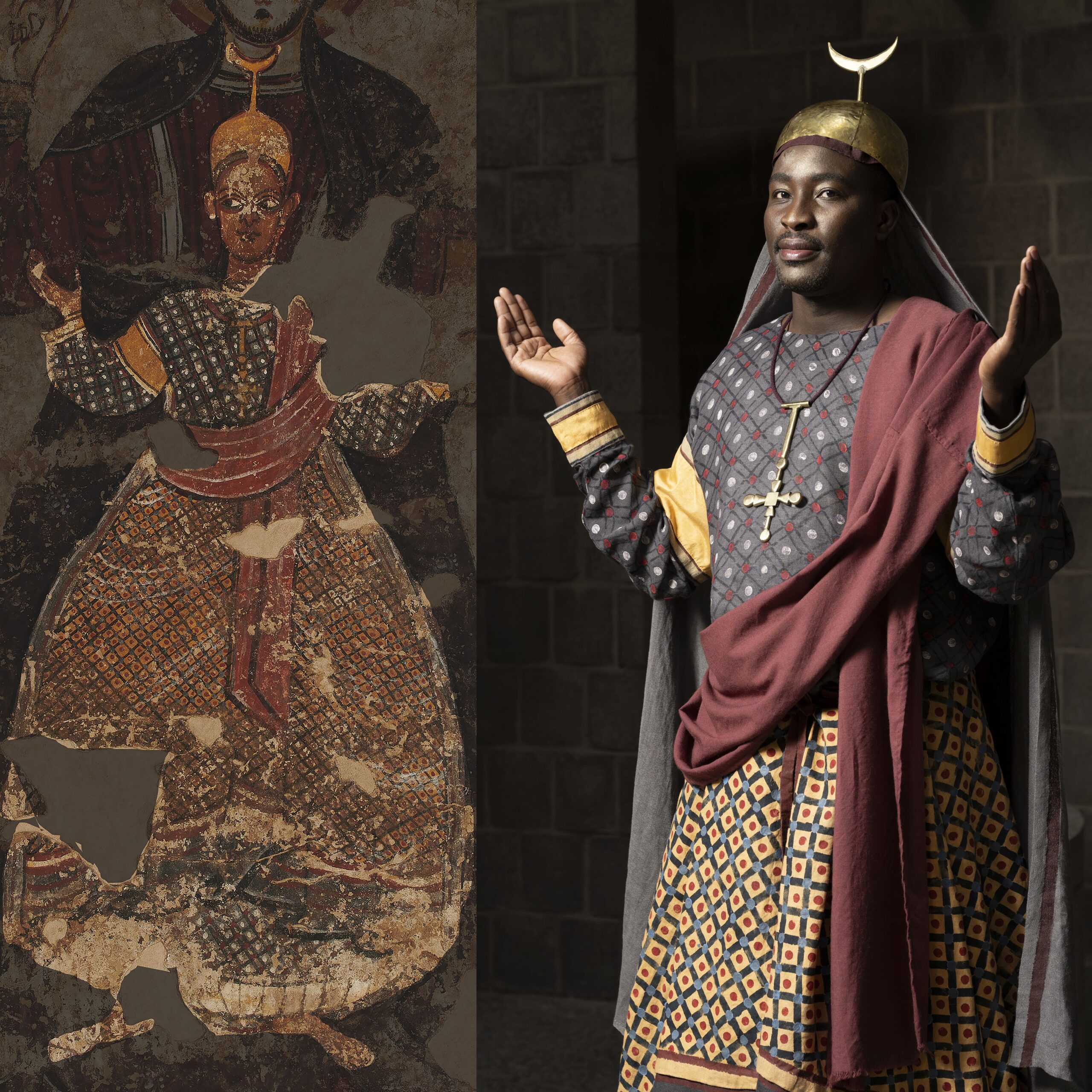Recreating history through fashion, researchers have revived the majestic attire of medieval Nubian royalty and clergy, showcased for the first time at the Louvre in Paris. These outfits, reconstructed from wall paintings in the cathedral of Faras, reveal the regal elegance and symbolism that once adorned the kingdom’s most influential figures.
Archaeologists from the University of Warsaw and designers from the SWPS University led the project to reconstruct five Nubian outfits based on Faras cathedral paintings, now held in the National Museum in Warsaw and the National Museum of Sudan in Khartoum.
Faras and the Kingdom of Makuria
Faras was a capital of Nobadia, later becoming the northern capital of the united kingdom of Makuria, which spanned modern southern Egypt and northern Sudan from the 6th to the 14th centuries. Polish interest in Nubia dates back to the 1960s, when Professor Kazimierz Michałowski led a University of Warsaw team to excavate in Faras. This UNESCO-backed expedition unveiled a treasure trove of Christian Nubian art, including the celebrated Faras cathedral with its well-preserved wall paintings.
An important element of the decor of Nubian churches were monumental images of court and clergy representatives, designed to connect the kingdom to divine authority and influence the faithful. Just like today, robes and decorative elements of clothing conveyed meaning through a non-verbal communication system, with each element carrying significance.
“We have practically no preserved, complete costumes from Nubia,” says Dr. Dobrochna Zielińska, an archaeologist from the University of Warsaw. “One tunic and bishop’s trousers have survived, but usually we only find fragments of clothing, because fabrics are extremely rare at archaeological sites. On the other hand, we also have a huge deficit of written sources concerning this place and originating from Nubia.”
In order to reconstruct the Nubian costumes, Dr. Zielińska, together with Dr. Karel Innemée and Dr. Magdalena Woźniak-Eusèbe, relied on iconographic sources. These paintings became the primary source of knowledge in their project, ‘Costumes of Authority. The Image of Royalty and Clergy in Christian Nubia,’ funded by the Polonez BIS programme of the National Science Centre.

Royal Ambitions Recorded in Fashion
‘”For reconstruction, we selected primarily two royal costumes and two costumes of royal mothers (from the 10th and late 12th centuries),” Dr. Zielińska added. “They showcase the change brought to Nubia by Christianity, which came from Constantinople in the 6th century. We believe that the ambition of the Kingdom of Makuria was to join the Christian world. And these ambitions are visible in the costumes. Especially at the beginning of Christianisation, all elements of royal costumes mirror the costumes of Byzantine emperors.”
Silks appeared over time among the fabrics, a trend mirrored by the Byzantine emperors, who also used luxurious fabrics imported from the East. In the 12th-century royal costume, references to elements of folk beliefs are evident, reflecting the Kingdom of Makuria’s increasing awareness of its own traditions. “Hence, for example, the moon appears on the royal crown. This is not the influence of Islam, but a local symbol that we already know from earlier eras and an element of the philosophy of seeing the world,” Dr. Zielińska explains.
Medieval Women and Power in Nubia
In medieval African cultures, including Nubia, it was women who transferred power. Dr. Zielińska explains that a Nubian ruler would be the son of the king’s sister rather than the king’s son. In the Byzantine Empire, there was no comparable role. Thus, the attire of the royal mother in Nubia was adapted to reflect this crucial role in succession.

“Both women’s costumes are richly decorated. Each element of the robe is decorated differently, but put together everything creates a harmonious whole, maintained in golden and earthy colours, and deep blue. The royal mother also has an absolutely unique crown topped with a pair of wings,” Zielińska says. Researchers suggest this crown may reference Isis, the Egyptian goddess of fertility and protector of families.
The later outfits of the royal mother integrates Eastern influences, with the woman dressed in a tunic and outer robe, draped around her figure. “Women in Sudan still wear a tunic, this is the traditional outer layer, which is put on when leaving the house, but also when entertaining guests. It is an elegant robe, but also a very practical one, because it protects against dust, sun, wind,” says Zielińska.
The Weight of Authority: Bishop’s Bells
Dr. Zielińska adds that the bishop’s clothing is more uniform than the court dress. The Nubian Church preserved what it received from Constantinople in the ‘Christianisation package,’ and, apart from minor details, the clothing of church dignitaries changed little over the centuries.

“However, one of these changes made a huge impression on us. The bishop’s attire was decorated with 130 brass bells, so when the bishop walked, we could hear him immediately. We only became aware of the role of these bells when reconstructing the attire. The bishop’s attire therefore is quite heavy, because while a single bell is very light, 130 bells weigh quite a bit,” Dr. Zielińska shares.
Experimental Archaeology in Action
The first task of the reconstruction team was to recreate the historical colours of the royal and priestly robes. This was achieved thanks to research from Dr. Magdalena Woźniak-Eusèbe of the University of Warsaw and dyeing expertise from Dr. Katarzyna Schmidt-Przewoźna of SWPS University.
“That was where our adventure began,” says Dr. Zielińska. “We wanted to see if we could use natural dyes to obtain the same colours as in the paintings. Was it the painter’s fantasy or was it based on reality? And that was the first moment that took our breath away. When we received the entire colour palette, we took the samples to the Faras Gallery in the National Museum in Warsaw and it turned out that the shades matched exactly.”

From the colour palette created by Dr. Schmidt-Przewoźna, costume designer Dorothée Roqueplo and Dr. Agnieszka Jacobson-Cielecka from SWPS University selected shades closest to the original colours, referencing collections of Nubian fabrics at the Textile Research Centre in Leiden and Faras paintings at the National Museum in Warsaw.
Patterns printed by stamps, hand embroidery, and appliqués were applied to fabrics dyed according to the palette. The most demanding task was to translate the two-dimensional, often unclear paintings into three-dimensional forms, understanding the layering of garments based on tradition and knowledge of Christian rites.
“In further work, it was necessary to combine various types of data, knowledge and, above all, intuition, imagination. Many decisions had to be made: what kind of fabric to sew a given element from; whether it was light, warm, stiff, or starched, because we know that starch was already used at that time. We can call this undertaking experimental archaeology,” Dr. Zielińska says.
The reconstructed costumes were presented at the Louvre last month during a special session by Sudanese representatives from the Netherlands and Germany. “Especially now, during the tragic civil war in Sudan, our activities have a chance to remind the world that not only the wonderful inhabitants of this country, but also its rich heritage are particularly endangered today,” the researchers say.
Our to thanks to Nauka w Polsce – www.scienceinpoland.pl for the original piece
Subscribe to Medievalverse










